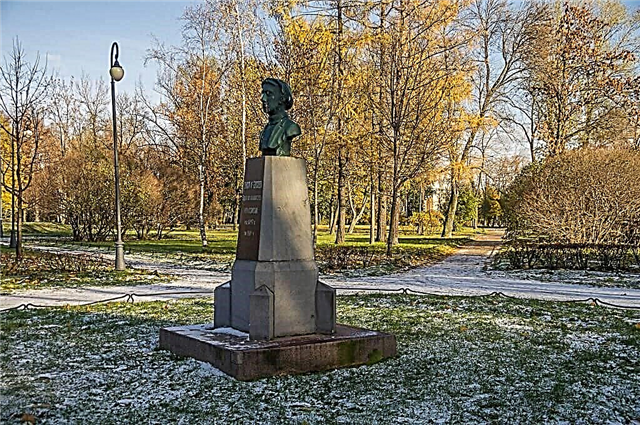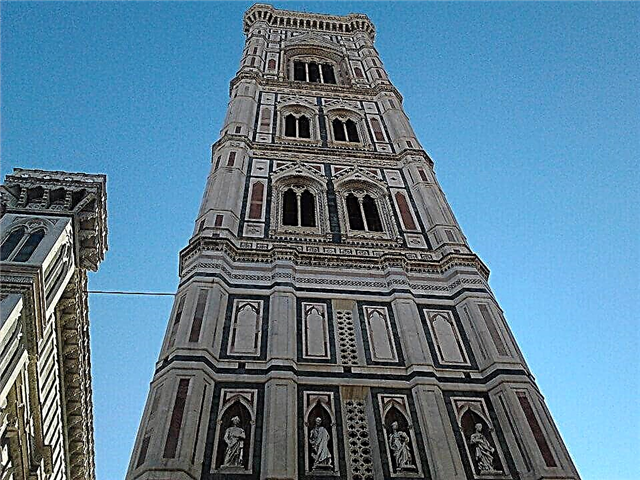Florentine architecture is a special kind of art. Walking through this old Italian city, you can explore the history and main attractions of the Renaissance: temples, palaces, bridges and squares. It is not in vain that Florence is considered the "cradle of the Renaissance". So Giotto's Campania in Florence is one of its most recognizable architectural landmarks.
What is Campanile

People who are far from art usually find it difficult to answer this question. Meanwhile, there is nothing complicated here: the campanile is a bell tower, which has the shape of a square or circle at its base, and stands apart from the building of the temple itself. Initially, campaniles were called similar in shape city towers of medieval Europe, and campanile-bell towers are already inherent in the Late Middle Ages and the Renaissance. Even if you don't know about Giotto's Campanile, another Italian Campanile you know for sure: the Leaning Tower of Pisa. Yes, the famous building in Pisa also belongs to this type of architecture.
Campanila Giotto is a favorite destination for all tourists who come to the city of Da Vinci and Alighieri for an experience. An ancient building of the 14th century, tall, majestic, with its grandiose history and the works of the greatest masters of the Renaissance, is admired by everyone who appreciates art and beauty at least a little.
Construction history

The bell tower was conceived, designed and laid down in the last years of the 13th century and was supposed to become a logical addition to the Catholic Cathedral of Santa Maria del Fiore, which was already under construction at that time. The initiator of the initial project and the author of the drawings of the campanile was Arnolfo Di Cambio, the architect of the cathedral itself. But Di Cambio's plans were not destined to come true: he soon died, and without his sensitive leadership, the construction of the campanile was suspended. For more than thirty years it stood in a barely begun state.
In 1334, another architect, Giotto Di Bondone, got down to business - it was his name that later received the bell tower. Giotto by that time was almost seventy years old, and behind him was the construction of the Basilica of Santa Croce, the Florentine abbey and the Basilica of St. Francis. In a word, he was well-known throughout Italy and a seasoned master.
It is known that the first stone was laid in the summer of 1334, and the grandiose construction quickly unfolded and gained strength. Giotto's project was, according to his contemporaries, delightful: the tower under construction looked exactly "painted on a heavenly canvas." To achieve this effect, the architect used several techniques at once: polychromy (multicolor), chiaroscuro (gradation of color distribution according to the principle of bright-pale, dark-light) and perspective (light-shadow ratio and the relationship between objects of the architectural ensemble).
In 1337, Giotto died, leaving the bell tower still unfinished: only the first tier of the future tower was erected. On three sides, graceful bas-reliefs are located, the authorship of which is still not known for certain: perhaps it was Giotto himself, or one of his assistants. In addition, there is a version that some of the bas-reliefs are already the work of Luca della Robbia and Andrea Pisano.
Pisano's work

Pisano is the third architect to take on the campaign. Respectfully approaching the work of his predecessor and his drawings, Pisano rigorously erected the bell tower as it was written and drawn in Giotto's plans. Under his leadership, the second and third tiers of the bell tower were erected and high windows were cut down. However, this time the construction lasted only five years: in 1348, a pandemic of the bubonic plague, then called the Black Death, began in Florence. Pisano himself died during a pandemic, and with him numerous workers who were building the tower.
Contribution of the architect Talenti
The fourth and last Italian architect to make a significant contribution to the construction of the bell tower is Francesco Talenti. It was he who erected the fourth, fifth and sixth levels and in 1359 solemnly completed the work. The campanile was faced with three types of marble: Carrara white, Pistois red and Pratsky green.
Unlike Pisano, Talenti did not strictly follow Giotto's plans. For example, he decided not to put a spire on the tower. The total height of the bell tower is 84.7 meters, according to Giotto's plans it should have been about 122 meters. Also under Talenti, a long and narrow staircase leading to the top of the tower was completely cut down. There are 414 steps on this staircase. Curiously, it is not spiral, as many think, so the climb is really very steep and very dangerous.
Timed admission ticket for Michelangelo's David - 16 €
Admission ticket to the Uffizi Gallery - 20 €
Uffizi Gallery: Priority Entrance € 40
Florence Cathedral: ticket with entry to the dome - 29 €
Entrance ticket and audio guide to Palazzo Vecchio - 19 €
Hop-on Hop-off tour. Ticket for 24, 48 or 72 hours - from 23 €
Leonardo da Vinci Museum: entrance ticket - 7 €
Tour to the Duomo with a guide and ascent to the top of the dome - 40 €
Entrance ticket to the Basilica of San Lorenzo - 8.50 €
Hot air balloon flight over Tuscany: Florence - 250 €
Architecture

Architecturally Campanile Giotto is an example of Florentine Gothic. Each of its tiers is a separate work of art and a separate landmark. For example, the bas-reliefs on the first tier bear an almost biblical, worldly, universal meaning: here - the creation of man, and human virtues, and the demonstration of professions, and sciences, and art, and even space with an innumerable number of its planets.
The second tier has its own beauty: 16 statues by Andrea and Nino Pisano, Donatello, Nanni di Bartolo and other masters. Today, the originals have been removed and placed in the Duomo Museum, and their exact copies are raised on the bell tower.
The third tier is empty, and the upper three are good for their high lancet windows, decorated with stucco and openwork. Each next tier is higher than the previous one, and this gives the impression that the bell tower stretches up into the heavens, and even heavy stone slabs and noble marble do not prevent it from being airy and light.
Viewpoint

The observation deck of the Giotto Campanile is multi-level and allows tourists to view Florence from different heights. On each tier there is an opportunity to go up to the windows and admire the picturesque views. The most dizzying picture, of course, opens from the sixth tier. To get here, you have to overcome on foot - no more, no less! - 414 steps.
But from the top of the bell tower, Florence can be seen from horizon to horizon: its flat square little houses with red tiled roofs, old winding streets, temples, palazzo, green hills. The sight is truly mesmerizing, as if admiring a gingerbread village from a European Christmas card.
In addition, from the observation deck of the bell tower, there is a special view of the nearest sights located directly on Cathedral Square. For example, from here in all details you can see the dome of the Cathedral of Santa Maria del Fiore, which is the work of Brunneleschi. It is curious to see from above the squat baptistery building with its pyramidal roof. In addition, the bell is located on the upper tier.
In the campanile, including the observation deck, everything is done for the convenience and safety of tourists who come here from all over the world. For example, you can rent small binoculars to see in great detail the dome of the cathedral, the tiled roofs of houses, and the hills on the horizon. There are also stationary binoculars, they act as a kind of telescopes.To prevent tourists from accidentally falling out of the fence, all dangerous spans are covered with bars. The lattice is strong, but thin enough not to interfere with admiring the beauty of the city.
Significance for the city

It is impossible to overestimate the significance of Giotto's campanile in Florence: one of the oldest architectural landmarks of the city, which has preserved the work of the greatest masters of the era - architects, sculptors, artists, is a favorite place for tourists, the best observation deck of the city, a building without which the entire silhouette of Florence will be different.
Cathedral Square, of which the bell tower is a part of the architectural ensemble, is one of the most visited places in the world. It's like the Eiffel Tower for Paris, Big Ben for London, the Hermitage for St. Petersburg. Grandiose, majestic, beautiful. Florentines tremblingly cherish the historical and cultural heritage of their city, including Giotto's campanile.
Opening hours and ticket prices

With the exception of holidays (Christmas, Easter, the Day of the Most Holy Theotokos) and special occasions, Giotto's Campanile is open every day. The entrance for tourists is open from 08.15. until 20.00. Unfortunately, there is no separate ticket for the bell tower for sale. The tourist needs to buy a general museum ticket in the amount of 18 euros. This ticket includes admission to the following attractions:
- Opera del Duomo Museum (this is where the originals of paintings, sculptures, reliefs, bas-reliefs and other works of art are located, copies of which are in the temple and the bell tower)
- the Catholic Cathedral of Santa Maria del Fiore, located in the center of the square, and its observation deck
- florentine baptistery
- crypt of Saint Reparat (underground burial)
- Campanile and its observation deck
The ticket gives the tourist the opportunity to visit each of the listed attractions once. You can buy it both at the box office in the square and on the official website, and e-ticket holders are skipped the queue. The ticket must be fully used within 72 hours of visiting the first attraction. In addition, for a fee, you can order an excursion, individual or group.
Where is it and how to get there
Campanile Giotto, like all other attractions that are part of the overall architectural ensemble, is located on Cathedral Square in the historic center of the city. Any bus or minibus going to the square will take the tourist to his destination. If you walk around Florence on foot, it will not be difficult to find the bell tower either: it proudly rises above half of the city, and is visible from any point in the historic center.











